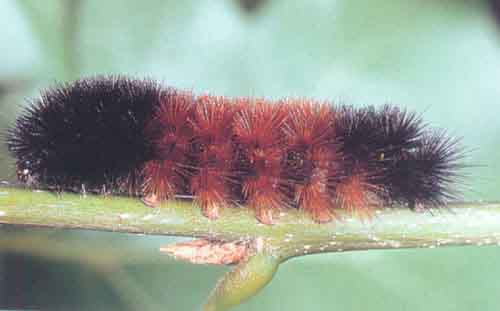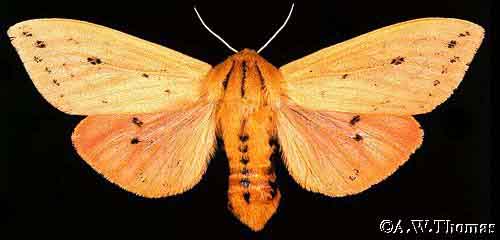The Isabella Tiger Moth:
Pyrrharctia isabella

Isabella Tiger Moth Caterpillar: Pyrrharctia isabella
This site has been created by
Bill Oehlke at oehlkew@islandtelecom.com
Comments, suggestions and/or additional information are welcomed by Bill.
New!
Caring for Woolly Bear CaterpillarsWoolly bear or fuzzy bear caterpillars are often found in the fall after they have left their
foodplants in search of a dark and sheltered spot where they can hibernate as larvae for the
winter. With springtime warmth, the woolly bear caterpillars again become active, feeding for a
brief time and then fashioning cocoons out of silk and body hairs.
Tiger moths usually emerge
from cocoons two to three weeks later.

Image of Pyrrharctia isabella moth courtesy of Anthony W. Thomas.
The Isabella Tiger Moth, (Pyrrharctia isabella, wingspan 4.0 - 5.5 cm) ranges throughout the
entire North American continent.
Pyrrharctia isabella caterpillars are densely coated with black hairs of equal length with
a girdle of the same length setae in red or orange. Two defensive postures are assumed when the larva is disturbed:
1) the woolly bear caterpillar curls up into a ball, or 2) the woolly bear caterpillar
"runs" away as fast as it can. The head is small and black.
Woolly bear caterpillars feed on a variety of grasses and weeds including plantain, dandelion and nettles.
Hibernation is usually over in northern portions of isabella's range in May. The
caterpillars feed briefly, spin their cocoons and then emerge a few weeks later as adult moths.
There are usually at least two generations in the North and possibly three or more generations in the South.
After dark, the female moth (larvae of females approach three inches in length) extends a scent
gland from the tip of her abdomen.
Night-flying males zigzag in their flights into the wind, pick up the airbourne scent with their
antennae, and locate and mate with the calling female.
Upon separating, the male looks for another mate while the female begins her ovipositing flight
under cover of darkness. Eggs are widely dispersed on a variety of hosts.
Male Pyrrharctia isabella moths come in to lights and rest with wings folded over their backs.
Pyrrharctia isabella caterpillars usually go unnoticed until fall when they seek out sheltered
over-wintering sites. The longer the caterpillar has been feeding and
the bigger it has grown, the narrower are the red-orange bands
girdling its middle. Thus, the width of the banding is an indicator
of the current or past season's growth rather than an indicator of
the length of the upcoming winter.
Dormancy can be induced in larvae by chilling them and keeping them cool. Larvae have been known
to survive an entire winter completely frozen in an ice cube. Warmth stimulates them,
and in an active state they require food.
Many people write to me after finding these caterpillars in late
fall and request information regarding their winter care. If the caterpillar is warmed, it will
need food or it will starve after a few days. If you have inadvertently warmed an
hibernating larva, the caterpillar can be rechilled and put back into cold storage until spring warmth brings fresh foliage.
As long as the caterpilar is kept cold, it will remain dormant. I recommend putting the caterpilar in a small tupperware
type container, lid on tight, no air holes or food. Mark the container and then put it in the refrigerator crisper where temps will
be cold enough to keep larva dormant for the winter until food is available again in the spring. In the spring, as long as the rearing
jar/container is kept clean and fresh foliage is supplied, the caterpillar will grow, spin its cocoon and then emerge
as a moth. Enjoy the much larger, more spectacular moths
depicted on the Saturniidae websites listed below.

Click on the flashing butterfly to show
appreciation for this site
and to visit other insect related
sites. |

|
or go to Introduction to
WORLD'S LARGEST SATURNIIDAE SITE and click on flashing
butterfly there. This site features spectacular photography with the
most extensive set of Saturniidae files found anywhere on the internet.
Woolly bear or fuzzy bear caterpillars come in a variety of colours and patterns, many of them
quite striking!
Click on the hypertext (blue print) below to access info and images of various Tiger Moth adults
and caterpillars:
ARCTIIDAE (TIGER MOTH) INDEX:
Larval images are from Caterpillars of Eastern Forests courtesy of David Wagner.
Visit other websites maintained by Bill Oehlke:
Have a nice day!
Go to
Caterpillar Identification









